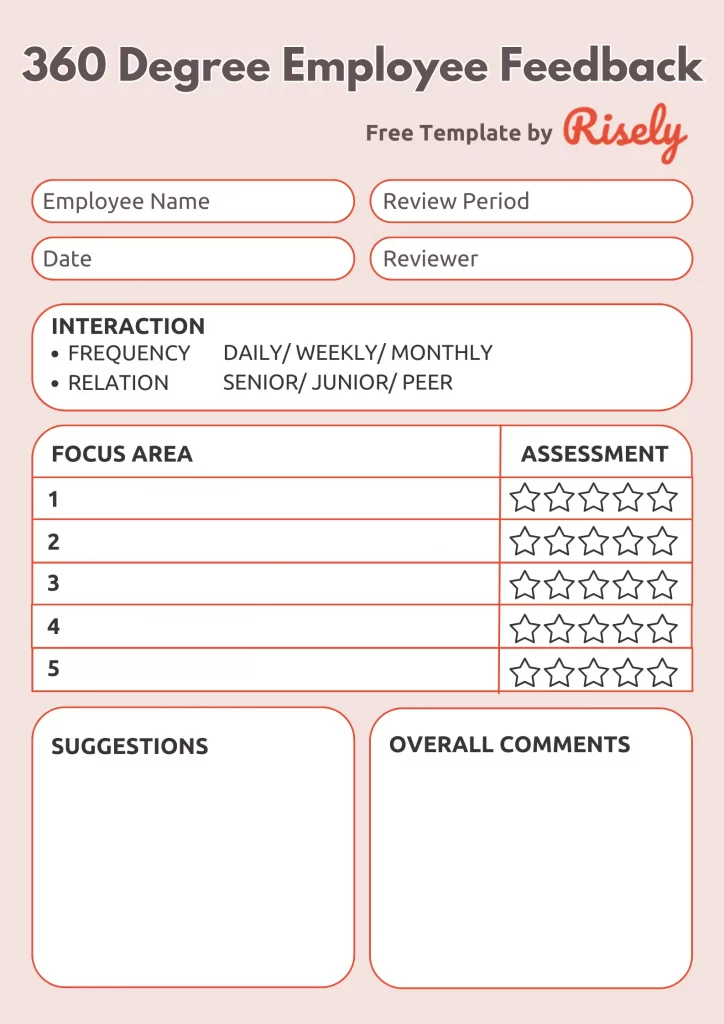7 Free Templates of Performance Review and Helpful Resources
Performance reviews can be daunting for managers, but they are an essential tool for evaluating employee performance and providing constructive feedback. Templates can simplify the process and ensure that all critical points are covered. This blog will provide an overview of performance reviews, including why they are essential and how to prepare for them. We will also discuss different types of performance review templates, best practices for using them effectively, and common challenges managers face during the process. Additionally, we will share helpful resources such as examples of effective performance reviews and tools/software to conduct reviews. By the end of this read, you will have a comprehensive guide to conducting successful performance reviews and improving your team’s overall productivity.Overview of Performance Reviews
Performance reviews are crucial in providing valuable employee feedback and evaluating job performance. These reviews help identify areas for improvement and development, contributing to employee engagement and satisfaction. By promoting open communication and transparency, they create a culture of honesty and accountability. Performance reviews are an essential tool for managers to assess the performance of their direct reports and provide helpful feedback. They enable employees to reflect on their work and set goals for the coming year. According to the Harvard Business Review, regular performance appraisals are essential for career development and can increase job satisfaction. Read more: Performance Management 101 for Leaders: 5 Steps to Ace the ProcessThe Importance of Performance Reviews for Managers
Performance reviews are crucial in helping managers assess their team members’ progress and performance. They offer an opportunity for managers to recognize and reward employees’ achievements, fostering a positive work environment. Additionally, performance reviews enable managers to identify areas where additional support or resources may be required, contributing to team members’ professional development and growth. Furthermore, these reviews serve as a platform for constructive feedback and coaching, allowing managers to provide helpful feedback to enhance employee performance. In summary, performance reviews are essential for managers to evaluate and nurture their team members’ skills and competencies.The Benefits of Using Templates for Performance Reviews
Using templates for performance reviews offers numerous benefits. Firstly, templates provide a structured framework for evaluations, ensuring consistency and fairness in the review process. They also save time and effort by providing a starting point for performance discussions. Templates help capture relevant information and track progress over time, allowing for a comprehensive assessment of employee performance. By using templates, organizations can improve the quality and effectiveness of their performance reviews, resulting in more meaningful and impactful evaluations.Templates of Performance Reviews
Annual Performance Review Template
The annual performance review template is essential for evaluating overall employee performance. It provides a comprehensive snapshot of achievements, areas for development, and future goals. This template includes self-assessment and manager feedback sections, allowing for a well-rounded evaluation. By assessing an employee’s performance over the past year, the template helps set the stage for career development discussions. It serves as an essential tool in identifying strengths, addressing weaknesses, and creating concrete steps for improvement. The annual performance review template fosters growth, communication, and continuous organizational improvement.
Mid-Year Performance Review Template
The mid-year performance review template is valuable for assessing employee performance and progress toward their goals. This template provides a structured framework for reviewing performance and offers an opportunity to address any challenges or roadblocks that employees may be facing. It includes sections for goal updates and feedback on performance, promoting accountability and alignment with objectives. The mid-year performance review template allows managers to effectively manage and support their employees’ ongoing development and performance improvement. Read more: Acing Mid-year Performance Reviews: 7 Useful Tips for Managers
Self-Evaluation Performance Review
The self-evaluation performance review is a valuable tool that empowers employees to reflect on their performance and contributions. It encourages self-awareness by prompting individuals to assess their accomplishments, challenges, and areas for growth. This process allows employees to participate in their professional development actively and provides valuable insights for constructive discussions with their managers.
360-Degree Performance Review
The 360-degree performance review offers a comprehensive view of an employee’s performance by collecting feedback from multiple sources, including peers, subordinates, and supervisors. This holistic approach provides a well-rounded perspective on an employee’s strengths and areas for improvement. It fosters a culture of collaboration, openness, and continuous feedback within the organization.
Career Path Performance Review
The career path performance review focuses on aligning an employee’s current performance with their long-term career goals. It explores how an individual’s skills, achievements, and development plans contribute to their desired career path within the organization. This type of review helps employees and managers chart a clear trajectory for professional growth and advancement.
Employee Skill Assessment
The employee skill assessment review evaluates their specific skills and competencies relevant to their role. It identifies areas where additional training or development may be needed and highlights the employee’s strengths. This review assists in tailoring learning and development plans to enhance job performance and career progression.
Employee Performance Rating
The employee performance rating systematically evaluates an employee’s performance based on established criteria and goals. It provides a structured way to assign ratings or scores to different aspects of an employee’s job performance. This rating system helps in objective performance measurement and serves as a basis for performance-related decisions, such as compensation and promotions.
Performance Review for Service Excellence
The performance review for service excellence evaluates employees in customer-facing roles or positions where service quality is paramount. It assesses an individual’s ability to deliver exceptional service, handle customer interactions effectively, and uphold the organization’s service standards. It is crucial for organizations that prioritize customer satisfaction. These various performance reviews serve distinct purposes within an organization and contribute to employee development, organizational improvement, and aligning individual and company goals. Each type can be tailored to suit the organization’s and its employees’ specific needs and priorities.
How to Prepare for a Performance Review?
To prepare for a performance review, set clear expectations and goals. Take the time to document specific examples of your achievements and challenges during the review period. Reflect on your strengths and areas for improvement. Gather feedback from colleagues and stakeholders to gain different perspectives on your performance. Additionally, consider your career aspirations and development opportunities for the coming year. By following these steps, you can ensure you are well-prepared and confident for your performance review.Conducting the Performance Review Meeting
To ensure a productive performance review meeting, creating a comfortable and non-judgmental environment is essential. Practicing active listening techniques promotes effective communication and encourages self-reflection and self-assessment from the employee. Providing specific examples to support feedback and evaluation adds clarity to the discussion. Additionally, discussing career development opportunities and future goals allows growth and improvement. By incorporating these strategies, the performance review meeting becomes a valuable tool for employee performance evaluation and development. Read more: How to Prepare for a Performance Review? Free Checklist for ManagersAsking the Right Questions
Asking the right questions is crucial in conducting an effective performance review. To ensure a productive conversation, preparing a list of thoughtful and relevant questions in advance is essential. Open-ended questions encourage detailed and meaningful responses, fostering honest communication. Tailoring questions to each employee’s unique role and responsibilities allows for a more personalized evaluation. Additionally, probing questions can delve deeper into specific performance areas, uncovering valuable insights. By asking the right questions, you can understand employee performance comprehensively. Find more here:- Questions To Ask And Never Ask : A Comprehensive Guide On Performance Reviews
- 15 Performance Review Questions That Drive Growth and Success
- Acing Mid-year Performance Reviews: 7 Useful Tips for Managers
Providing Feedback and Constructive Criticism
Delivering feedback constructively and respectfully is essential for effective performance reviews. When providing feedback, it’s necessary to focus on specific behaviors and actions rather than personal traits. Offering clear and actionable suggestions for improvement gives employees a roadmap for growth. Balancing positive feedback with areas for improvement creates a well-rounded evaluation. By utilizing these strategies, managers can provide helpful feedback that enhances employee performance and fosters professional development.Other Interesting Reads
Using Performance Review Templates Effectively
The Dos and Don’ts of Using Templates
Customizing templates to fit the unique needs of each employee is essential. Providing specific examples and evidence to support ratings adds credibility to the feedback. However, relying solely on templates without personalizing the feedback should be avoided, as it may undermine its effectiveness. Templates should be used as a guide to ensure consistency and fairness, but they should not be seen as a substitute for meaningful conversations. By appropriately using templates, managers can balance structure and personalization in the performance review process.Customizing Templates to Suit Your Team’s Needs
To customize templates to suit your team’s needs:- Consider tailoring them to reflect your team’s objectives. You can choose from a number of performance review rating scales available.
- Incorporate specific competencies and skills relevant to your industry.
- Customize rating scales and performance indicators based on job roles, seeking input from team members during the customization process.
- Remember to review and update templates to ensure their effectiveness regularly.
- Keep performance review scales calibrated across your teams.
Best Practices for Improving Performance Reviews
Providing ongoing feedback throughout the year, rather than just during formal reviews, is a crucial best practice for improving performance reviews. Encouraging employees to engage in self-assessment and self-reflection can also enhance the review process. Creating a culture of continuous learning and development fosters growth and improvement. Training managers in effective feedback and evaluation techniques equip them with the skills needed to conduct meaningful reviews. Additionally, technology can streamline and enhance the performance review process, making it more efficient and accurate.Conclusion
To make the most out of your performance reviews, it is essential to have a structured approach. By using templates, you can streamline the process and ensure consistency across reviews. Whether it’s an annual, mid-year, or project-based review, having a template will help you gather all the necessary information and provide constructive feedback. However, it’s crucial to customize the template to suit your team’s specific needs. Additionally, encourage two-way communication during the review meeting, set clear objectives, and identify growth opportunities. Overcoming biases and addressing conflicts are common challenges managers face, but with the right tools and resources, you can navigate them effectively.Templates are just the start. AI co-pilot can help you do more!
Check out Risely’s skill assessments for free today to unravel a new way of growth.
Other Related Blogs
How to build and retain high performing employees? | Laletha Nithiyanandan
How to build and retain high performing employees? | Laletha Nithiyanandan Are you really an HR if you have not spent hours chasing the ideal high performing employees for your…
How Can You Build A High Performing Culture? 7 Hacks
How Can You Build A High Performing Culture? 7 Hacks We have all heard of dream teams and tried to build them with varying levels of success and failure. Among…
10 Effective Manager Performance Goals to Drive Team Success
10 Effective Manager Performance Goals to Drive Team Success You’re sitting across from a manager in a performance review meeting. They seem unsure, disconnected from the company’s vision, and oblivious…
How to Build a High-Performing Team?
How to Build a High-Performing Team? Creating a high-performing team is a goal that every organization aspires to achieve. A high-performing team achieves superior results and can quickly adapt to…


